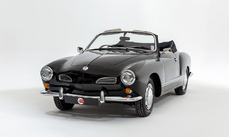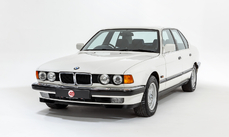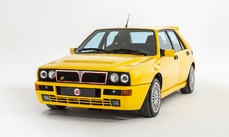Mitsubishi Lancer Evo III GSR 1995
General description :
Model History
Flush with success from its Galant VR-4 and hungry for WRC victory, Mitsubishi determined in 1990 that further success would require a new platform. To that end, Mitsubishi engineers started with VR-4’s proven drivetrain and shoehorned it into the lighter, smaller Lancer chassis.
The Evolution I was introduced in 1992 to compete in the World Rally Championship. It used the 2-litre turbocharged DOHC engine and 4WD drivetrain from the original Galant VR-4 in a Lancer chassis, and was sold in GSR and RS models. The latter was a stripped-down club racing version that lacked power windows, anti-lock brakes, a rear wiper, and had steel wheels to save approximately 70 kg less than the 1238 kg GSR, while the former came with all of the conveniences of a typical street car. It came with Mitsubishi’s 4G63 engine producing 244hp at 6,000 rpm and 228 ft lb at 3,000 rpm, along with all-wheel drive, which would become a trademark on all Evo models.
Mitsubishi’s intention was to improve power output with each Evolution, and the Evo II started the trend. But with speeds on tarmac stages getting higher, reducing lift and improving cooling performance became the priority for the Evo III. A larger rear wing, front airdam with brake cooling vents, and rocker panel extensions were fitted and, of course, power was up again.
The Evo III arrived in January 1995 looking a lot more serious than its predecessor. It sported a new front end (to channel air better to the radiator, intercooler, and brakes), new side skirts and rear corners, and the rear wing had grown drastically to reduce lift. Under the vented aluminium bonnet a new TDO5-16G6-7 Turbo, new exhaust system, and increased compression brought another 10hp rise over the Evo II, although torque output was unaltered aside from a higher final drive ratio. Both GSR and RS versions still used the same five-speed gearbox. Interior tweaks were limited to a new Momo steering wheel and new fabric on the Recaro seats.
Equipment
Recaro SRD front seats, Digital climate control air conditioning, Electric windows front and rear, Electrically adjustable and folding door mirrors, Mitsubishi cassette radio, Diatone/Mitsubishi speaker system, Electric aerial, Leather Momo steering wheel, Leather gear knob, Rear wiper, GSR bodykit with colour-matched door handles and mirror covers, Front and rear strut braces, Cusco coil-over suspension, Remote central locking with spare key, Space saver spare wheel, Wheel brace, Jack, Original Mitsubishi document pack and service booklet, Original Evo III sales brochure, BIMTA mileage verification certificate.
Exterior
This handsome little Evo looks great in its original paint scheme of Queens Silver with OZ alloys in white. The panels are nice and straight along both sides and while the body is not 100% blemish-free the car still presents to a great standard overall. The paint retains a glossy finish throughout, the lights are crystal clear, and the decals at the rear look new. Better still, having resided on the salt-free roads of Japan until 2018, this example is lovely and solid underneath with no rust issues. Upon arrival into the UK the car was treated to a bespoke stainless exhaust system with OEM-style dual exhaust tips – a rare sight on any Evo!
Interior
The factory finish continues inside. The cabin is well appointed with fully operational digital climate control AC, electrically adjustable and folding door mirrors, front and rear electric windows, the original cassette radio and of course those high-back Recaro front seats. Free from any unsightly modifications or “upgrades” the interior space remains just as it did leaving the factory. There are no holes in the dash from aftermarket gauges and the seats show almost no wear to the deep bolsters. In the foot wells you’ll still find the original set of Lancer carpet mats with only the driver’s heel pad a little worn.
ENGINE & TRANSMISSION
Under the bonnet there are no engine mods to be found – even the factory blow-off valve is still fitted. The turbocharged 2-litre 4G63 engine has recently been serviced and had the timing belt replaced. The Evo has now driven a fully documented 75k miles from new. The Japanese maintenance history is all Mitsubishi, and a service at Mitsubishi was carried out upon arrival into the UK about 1,300 miles ago. The timing belt was replaced shortly after.
WHEELS, TYRES & BRAKES
The Evo III’s arches are filled perfectly with the factory 15-inch five-spoke OZ alloys. Having never needed refurbishment they all present in their original coat of white with the correct red decals and centre badges. The wheels are shod in a recently fitted matching set of Toyo Proxes 205/60 R15 tyres with less than 500 miles of wear.
History File
With a total of just 7,000 Evo IIIs produced between January 1995 and August 1996, low mileage and original examples such as this rarely come up for sale. This car was first registered in February ’95. The low mileage of just 75k is fully verified by a comprehensive Mitsubishi service record, as detailed in the original document pack (and listed below). A BIMTA Certificate of Mileage Verification also accompanies the car.
08/02/1998 at 25,120km / 15,609 miles – Saitama Mitsubishi20/02/2000 at 38,888km / 24,164 miles – Saitama Mitsubishi26/02/2002 at 51,728km / 32,142 miles – Saitama Mitsubishi21/02/2004 at 66,696km / 41,443 miles – Saitama Mitsubishi15/07/2006 at 79,443km / 49,364 miles – Saitama Mitsubishi10/02/2008 at 92,069km / 57,209 miles – Kanto Mitsubishi27/02/2010 at 104,998km / 65,243 miles – Kanto Mitsubishi03/03/2012 at 109,419km / 67,990 miles – Kanto Mitsubishi24/02/2014 at 111,922km / 69,545 miles – Kanto Mitsubishi04/10/2015 at 114,173km / 70,944 miles – Kanto Mitsubishi11/09/2016 at 115,787km / 71,947 miles – Kanto Mitsubishi06/03/2017 at 116,800km / 72,576 miles – Kanto Mitsubishi29/09/2017 at 118,373km / 73,554 miles – Kanto Mitsubishi11/04/2018 at 118,974km / 73,927 miles – Farnham Mitsubishi
Since arriving in the UK the Evo has been treated to a new stainless steel exhaust system, a service at Mitsubishi and a timing belt change. The car is fully UK-registered and the MOT is valid until May 2020. Given its low mileage, provenance and originality this car represents an excellent investment opportunity for the collector or like-minded enthusiast.
http://www.4starclassics.com/for-sale/mitsubishi-lancer-evo-iii-gsr-for-sale/
1995 Mitsubishi Lancer Evo III GSR is listed sold on ClassicDigest in Kingsley by 4 Star Classics for £12995.
Car Facts
Car type : Car Make : Mitsubishi Model : Lancer Model Version : Evo III GSR Engine size : 2.0 Model Year : 1995 Sub type : Race/Rally Car Location : Hampshire
Sold
Seller Information
Sold
People who viewed this Mitsubishi Lancer also viewed similar Mitsubishi listed at ClassicDigest
Other cars listed for sale by this dealer
About Mitsubishi
Mitsubishi: A Journey Through History (Up to the 1980s)**1. Early Beginnings:
Foundation: Mitsubishi's roots trace back to the establishment of a shipping firm by Yataro Iwasaki in 1870.
Diversification: The company expanded into coal mining, shipbuilding, and other industries, forming the basis for the Mitsubishi Group.
**2. Automotive Ventures Begin:
Initial Automobile Production: Mitsubishi ventured into automobile manufacturing in the early 20th century.
Model-A: In 1917, Mitsubishi introduced its first production car, the Model-A, Japan's first series-production automobile.
**3. Post-War Era:
Restructuring: Following World War II, Mitsubishi faced challenges but underwent restructuring and resumed automobile production.
Jeep Production: Initially focused on producing Jeeps, Mitsubishi made significant contributions to Japan's automotive recovery.
**4. Milestone Models:
Mitsubishi 500: Introduced in 1960, the Mitsubishi 500 was a compact car that played a role in popularizing smaller vehicles in Japan.
Mitsubishi Colt 600: Released in 1962, the Colt 600 was a subcompact car contributing to Mitsubishi's expansion in the automotive market.
**5. Global Expansion and the 1970s:
Partnerships: Mitsubishi forged partnerships with international automakers, expanding its reach beyond Japan.
Galant and Lancer: Models like the Galant and Lancer gained popularity during the 1970s, showcasing Mitsubishi's commitment to innovation and performance.
**6. Technological Advancements:
Mitsubishi Astron Engine: Introduced in the 1970s, the Astron engine became a staple in Mitsubishi vehicles, known for its durability and efficiency.
**7. Pinnacle of the 1980s:
Mitsubishi Pajero: Launched in the early 1980s, the Pajero (Montero in some markets) marked Mitsubishi's entry into the SUV segment, becoming a global success.
Starion: The Starion, introduced in the mid-1980s, was a sports car that showcased Mitsubishi's performance capabilities.
**8. Mitsubishi Classic Models of the 1980s:
Mitsubishi Delica: The Delica, first introduced in the 1960s but gaining popularity in the 1980s, was a versatile van available in various configurations.
Mitsubishi Mighty Max: This compact pickup truck was known for its durability and practicality.
Mitsubishi Mirage: The Mirage, available in hatchback and sedan versions, became a popular choice for fuel efficiency and reliability.
Mitsubishi's journey through the 1980s reflects its evolution from a diversified conglomerate to a prominent player in the global automotive industry. The decade saw the introduction of iconic models that contributed to Mitsubishi's reputation for innovation and performance.







